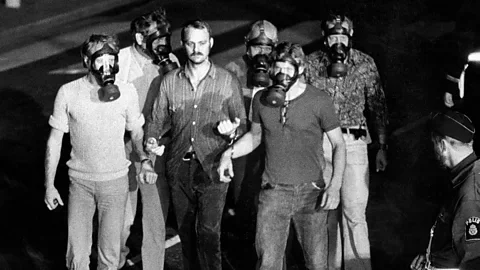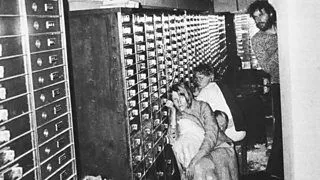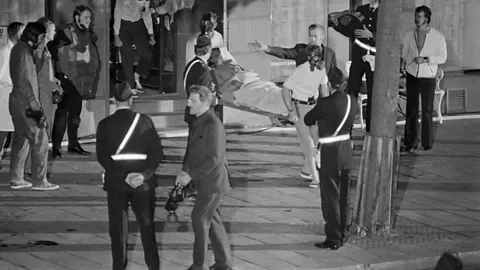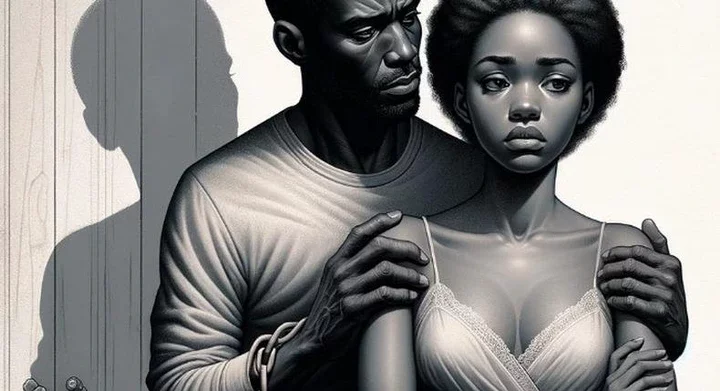
The six-day bank siege that inspired the controversial Stockholm Syndrome theory began on 23 August 1973. In 1980, a BBC documentary featured two pioneering New York police negotiators who had built their careers on the lessons they had learnt from hostage situations past, including this bizarre robbery attempt.
"But Sven, it's only in the leg."
Those were the words of Kristin Enmark, 23, who was one of four people being held hostage at gunpoint in a Swedish bank. It was day two of the siege, and robber Jan-Erik Olsson wanted to show the police he meant business by shooting her terrified bank colleague Sven Säfström.
Enmark told the BBC's Witness History in 2016: "Jan said to him, 'I'm not going to hurt any bones in your leg; I'm just going to shoot in the part that is not going to make so much injury'."
Looking back, she struggled to comprehend her callous reaction. She said: "In that situation, I thought that he was somehow being a coward, not letting himself be shot in the leg. I think it's awful for me to think that and to say that, but I also think it shows what can happen to people when they are in a situation that is so absurd. It is a situation that makes this moral shift. I really feel ashamed about this."
Although Olsson did not carry out his plan, Säfström later admitted he had also felt grateful to his captors, and had to force himself to remember these were violent criminals and not his friends.

The term Stockholm Syndrome was coined in the aftermath of the siege by Swedish criminologist and psychiatrist Nils Bejerot to explain the apparently irrational affection that some captives felt for their hostage-takers. The theory reached a wider audience a year later when Californian newspaper heiress Patty Hearst was kidnapped by revolutionary militants. The 19-year-old appeared to develop sympathy for her captors, and joined them in a robbery. She was eventually caught and received a prison sentence. According to her defence lawyer, she had been brainwashed and was suffering from Stockholm Syndrome.
The art of police hostage negotiation was pioneered in the 1970s by New York cops Frank Bolz and Harvey Schlossberg. The idea came out of the botched rescue at the 1972 Munich Olympics, when 11 Israeli athletes were killed after being taken captive by members of a Palestinian militant group. In 1980, Bolz and Schlossberg featured in the BBC documentary Inside Story: Hostage Cops and explained that the NYPD hostage negotiation team was set up because of fears something similar could happen in the city. Their aim was to safely de-escalate situations instead of going in Hollywood-style with all guns blazing. Delaying tactics gave hostage-takers more time to make errors, and created room to build rapport with their captives, making a violent end less likely.
The more stress in the situation, the quicker the relationship, and the more intense it's going to be - Harvey Schlossberg
By the end of the 1970s, about 1,500 police forces had sent officers to New York to learn from Bolz's practical experience of more than 200 hostage incidents. These lessons travelled even further when a BBC documentary crew sat in on a masterclass delivered by Bolz and Schlossberg, a former traffic cop with a doctorate in psychology. For Schlossberg, Stockholm Syndrome - or Survival Identification Syndrome - was not a complicated concept.
"We simply mean when two or more people get together, they form a relationship - that's all it is," he said. "Of course, the more stress in the situation, the quicker the relationship, and the more intense it's going to be. When people are in crisis, and they're not sure about what's going to happen, the one thing we're all afraid of is going insane. I mean, we're always worried about, are we losing our mind? Is this really happening to me? What am I doing in a thing like that? Am I experiencing this? And what we do is we want to test our feelings against another person, because if that person is sharing this experience and he's seeing the same thing, and he ain't going bananas and this is really happening, maybe it's OK."
Schlossberg said that while criminals would often put hostages on the telephone to speak to negotiators, there was no point trying to obtain secret information from them: "The hostage will tell the criminal everything you tell him. They make terrible witnesses and when they get released, the intelligence information they give you should be taken for what it's worth."
Bolz said that when hostage-takers made demands it was important not to dismiss them outright. He said: "You never tell him no, but you don't necessarily tell him yes. It's always, 'Let me see what I can do - let me try for you'."
Schlossberg said it was vital that police kept control of the situation, insisting that the hostage-taker "will talk to our negotiator or he talks to no one". "We don't want lawyers, mothers, priests - we don't want them talking," he said. "The fantasy is, you're going to talk to no one unless you get the person you want to talk to. The reality is, how long could you sit in this room and not make contact with the outside world?"
Under siege
At the time of the Stockholm siege, none of these lessons was available to Stockholm police, who made a series of rookie errors that would not happen today. When Olsson blasted his way into the Sveriges Kreditbanken, he demanded three million Swedish krona, a getaway car, and another criminal to be delivered to him from jail. While he didn't get the money or the car, psychiatrist Nils Bejerot advised police to acquiesce to his request that Clark Olofsson, one of Sweden's most infamous criminals, be brought to the bank in Stockholm's Norrmalmstorg Square. Olofsson was tasked to work as an inside man in exchange for a reduced sentence.
Over the course of the siege, the four hostages and two criminals began to develop an unlikely bond inside the bank vault
Bejerot is the man who coined the term Norrmalmstorg Syndrome, later known as Stockholm Syndrome. For some, this theorising was an attempt to deflect attention away from the mistakes made by him and police colleagues during the siege, by instead putting the blame on victims.
Over the course of the siege, the four hostages and two criminals began to develop an unlikely bond inside the bank vault, amid apparent acts of kindness by the captors. In contrast, the captives expressed more hostility towards the police, fearing that any attempt to end the stand-off might end in them being killed.
Hostage Kristin Enmark was persuaded by the charismatic Olofsson to have a telephone conversation with Olof Palme, the actual Swedish prime minister. She begged to be allowed to leave the bank in a getaway car with the kidnappers, telling him: "I think you are sitting there playing checkers with our lives. I fully trust Clark and the robber. I am not desperate. They haven't done a thing to us. On the contrary, they have been very nice. But you know, Olof, what I'm scared of is that the police will attack and cause us to die."
Looking back in 2016, Enmark told the BBC: "I wish that that phone call never had happened because it was a meaningless call. I was sitting there asking for my life. He was the prime minister. What could he say?"

For several days, the hostages were held inside a bank vault while surrounded by armed police. Officers eventually decided to break through the ceiling and use tear gas to disarm the kidnappers. Police shouted for the hostages to come out first, but they refused, believing that the captors would be shot. Instead, as the criminals walked out, they stopped in the doorway to embrace two of the female captives. Hostage Säfström, who had earlier narrowly escaped being shot, received a manly handshake.
It was behaviour that baffled many of the Swedish public who had for days been gripped by the dramatic events at the bank. While Bejerot diagnosed Stockholm Syndrome without even speaking to Enmark, the theory had the air of a plausible explanation, and it caught the imagination of the international media.
For New York hostage negotiators Frank Bolz and Harvey Schlossberg in 1980, the concept could be seen as a useful teaching aid to describe interpersonal dynamics in a traumatic situation. However, the label is a complete misrepresentation of Kristin's experience, according to Dr Allan Wade, a Canadian therapist who has spoken at length with her. He told BBC Reel in 2023: "The term Stockholm Syndrome has long roots in psychoanalytic thinking in Europe. But in that moment, it was used to silence and discredit an angry young woman who had been resisting violence, protecting herself and other people for six and a half days. It was used to protect the police response."
Kristin said in 2016 that she remained friends with Oloffson, the man taken from prison to meet the demands of robber Olsson. Dr Wade said that during the siege, the prisoner "was actually working in a way to try to make some of the people feel safer, and if you treat Clark Olofsson as though he was simply another one of the captors, you would have a very difficult time understanding why Kristin or others might have some sense of a positive recollection of him".
Speaking on the BBC's Sideways podcast in 2021, Kristen had a blunt assessment of Stockholm Syndrome.
"It's bullshit, if you can say that on the BBC. It's a way of blaming the victim. I did what I could to survive."
(BBC)
















Comments